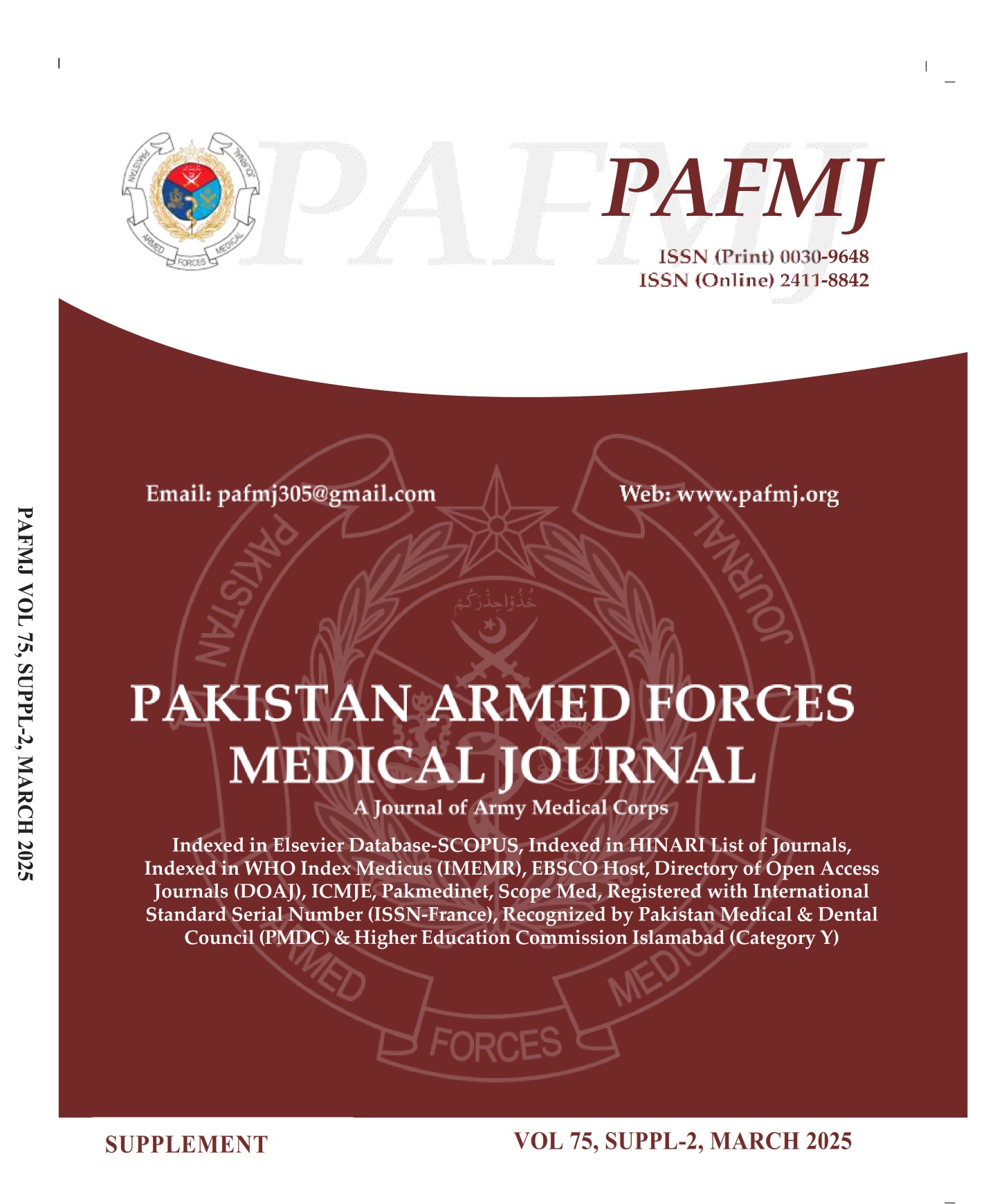Comparison of Nasal Tragus Length and Formula For Correctness of Endotracheal Tube Placement in Neonates
DOI:
https://doi.org/10.51253/pafmj.v75iSUPPL-2.5644Keywords:
endotracheal intubation; methods; neonates; Neonatal intensive care unitAbstract
Objective: To compare the nasal tragus length and weight+6 cm formula for correctness of endotracheal tube placement in neonates.
Study Design: Comparative Prospective Study.
Place and Duration of Study: Pak Emirates Military Hospital, Rawalpindi Pakistan, from Jul 2019 to Apr 2020.
Methodology: A prospective study was conducted on the neonates requiring endotracheal intubation in the neonatal intensive care unit. Patients were randomly divided into two groups via lottery method. In Group A nasal tragus length +1cm was used to estimate the length of intubation while in group B weight+6 cm formula was used for the same purpose. Correct placement of the endotracheal tube was ascertained by the chest x-ray in both the groups.
Results: A total of 300 patients were included into the final analysis. Out of them 249(83%) had correct placement of tube while 51(17%) had incorrect placement on chest x-ray. 167(55.7%) underwent endotracheal intubation with formula of weight+6 cm while 133(44.3%) underwent with nasal tragus length+1 cm. Chi-square analysis revealed that nasal tragus length has statistically significant relationship with correct placement of the endotracheal tube among the neonates managed at nursing intensive care unit (p-value<0.05).
Conclusion: Considerable number of neonates had incorrect placement of endotracheal tube in our study on chest x-ray. Nasal tragus length +1 cm emerged as a better method for correct placement of endotracheal tube in our target population as compared to weight +6 cm formula used for the same purpose.
Downloads
References
Al-Wassia H, Saber M. Admission of term infants to the neonatal intensive care unit in a Saudi tertiary teaching hospital: cumulative incidence and risk factors. Ann Saudi Med 2017; 37(6): 420‐424. https://doi:10.5144/0256-4947.2017.420
Quddusi AI, Razzaq A, Hussain S, Hussain A. Pattern of neonatal admission at the Children's Hospital and the Institute of Child Health, Multan. J Ayub Med Coll Abbottabad 2012; 24(2): 108‐110
Chow S, Chow R, Popovic M, Lam M, Popovic M, Merrick J et al., A Selected Review of the Mortality Rates of Neonatal Intensive Care Units. Front Pub Health. 2015; 3(1): 225. Published 2015 Oct 7. https://doi:10.3389/fpubh.2015.00225
Hatch LD, Grubb PH, Lea AS, Walsh WF, Markham MH, Whitney GM et al. Endotracheal Intubation in Neonates: A Prospective Study of Adverse Safety Events in 162 Infants. J Pediatr 2016; 168(3): 62‐6.e6.
https://doi:10.1016/j.jpeds.2015.09.077
Schmölzer GM, O'Reilly M, Davis PG, Cheung PY, Roehr CC. Confirmation of correct tracheal tube placement in newborn infants. Resuscitation 2013; 84(6): 731‐737.
https://doi:10.1016/j.resuscitation.2012.11.028
Schmölzer GM, Roehr CCC. WITHDRAWN: Techniques to ascertain correct endotracheal tube placement in neonates. Cochrane Database Syst Rev 2018; 7(7): CD010221.
https://doi:10.1002/14651858.CD010221.pub3
Gray MM, Delaney H, Umoren R, Strandjord TP, Sawyer T. Accuracy of the nasal-tragus length measurement for correct endotracheal tube placement in a cohort of neonatal resuscitation simulators. J Perinatol 2017; 37(8): 975‐978. https://doi:10.1038/jp.2017.63
Uygur Ö, Öncel MY, Şimşek GK, Okur N, Çelik K, Bozkurt Ö et al. Is Nasal Septum-Tragus Length Measurement Appropriate for Endotracheal Tube Intubation Depth in Neonates? A Randomized Controlled Study. Am J Perinatol. 2021 Jun; 38(7): 728-733.
Flinn AM, Travers CP, Laffan EE, O'Donnell CP. Estimating the endotracheal tube insertion depth in newborns using weight or gestation: a randomised trial. Neonatology 2015; 107(3): 167‐172. https://doi:10.1159/000369375
Merali HS, Tessaro MO, Ali KQ, Morris SK, Soofi SB, Arrif S. A novel training simulator for portable ultrasound identification of incorrect newborn endotracheal tube placement – observational diagnostic accuracy study protocol. BMC Pediatr 2019; 19 (1): 434-444.
Takeuchi S, Arai J, Nagafuji M, Hinata A, Kamakura T, Hoshino Y, et al., Ideal endotracheal tube insertion depth in neonates with a birthweight less than 750 g. Pediatr Int 2020; 62(8): 932-936. https://doi: 10.1111/ped.14245.
Zaytseva A, Kurepa D, Ahn S, Weinberger B. Determination of optimal endotracheal tube tip depth from the gum in neonates by X-ray and ultrasound. J Matern Fetal Neonatal Med 2020; 33(12): 2075‐2080. https://doi:10.1080/14767058.2018.1538350
Singh P, Thakur A, Garg P, Aggarwal N, Kler N. Normative Data of Optimally Placed Endotracheal Tube by Point-of-care Ultrasound in Neonates. Indian Pediatr 2019; 56(5): 374-380.
Bartle RM, Miller AG, Diez AJ, Smith PB, Gentile MA, Puia-Dumitrescu M. Evaluating Endotracheal Tube Depth in Infants Weighing Less Than 1 Kilogram. Respir Care 2019; 64(3): 243‐247. https://doi:10.4187/respcare.06202
Sawyer T, Foglia EE, Ades A, Moussa A, Napolitano N, Glass K et al., Incidence, impact and indicators of difficult intubations in the neonatal intensive care unit: a report from the National Emergency Airway Registry for Neonates. Arch Dis Child Fetal Neonatal Ed 2019; 104(5): F461‐F466.
https://doi:10.1136/archdischild-2018-316336
Wang TC, Kuo LL, Lee CY. Utilizing nasal-tragus length to estimate optimal endotracheal tube depth for neonates in Taiwan. Indian J Pediatr 2011; 78(3): 296‐300.
https://doi:10.1007/s12098-010-0278-8
Peterson J, Johnson N, Deakins K, Wilson-Costello D, Jelovsek JE, Chatburn R. Accuracy of the 7-8-9 Rule for endotracheal tube placement in the neonate. J Perinatol 2006; 26(6): 333‐336. https://doi:10.1038/sj.jp.7211503
Shukla HK, Hendricks-Munoz KD, Atakent Y, Rapaport S. Rapid estimation of insertional length of endotracheal intubation in newborn infants. J Pediatr 1997; 131(4): 561‐564. https://doi:10.1016/s0022-3476(97)70062-3
Tatwavedi D, Nesargi SV, Shankar N, Rao S, Bhat SR. Evaluation of body parameters for estimation of endotracheal tube length in Indian neonates. Eur J Pediatr 2015; 174(2): 245‐249. https://doi:10.1007/s00431-014-2388-1
Downloads
Published
Issue
Section
License
Copyright (c) 2025 Kiran Zeb, Asma Razzaq, Misbah Fakih, Muhammad Shoaib

This work is licensed under a Creative Commons Attribution-NonCommercial 4.0 International License.















